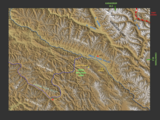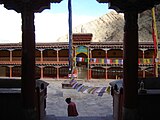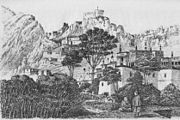Hemis National Park (or Hemis High Altitude National Park) is a high altitude national park in the easternLadakh region of the state of Jammu and Kashmir in India. World famous for being the best place to see the snow leopard in the wild, it is believed to have the highest density of snow leopards of any protected area in the world.[1] It is the only national park in India north of the Himalayas, the largest notifiedprotected area in India (and thus the largest national park of India), and is the second largest contiguous protected area after the Nanda Devi Biosphere Reserve and surrounding protected areas. The park is home to a number of species of endangered mammals including the snow leopard. Hemis National Park is India's only protected area inside the Palearctic ecozone, outside the Changthang Wildlife Sanctuary northeast of Hemis, and the proposed Tso Lhamo Cold Desert Conservation Area in North Sikkim.
Quick facts: Hemis National Park Hemis NP, Country ...
The park is bounded on the north by the banks of the Indus River, and includes the cachements of Markha, Sumdah andRumbak, and parts of the Zanskar Range.
History
The park was founded in 1981 by protecting the Rumbak and Markha catchments, an area of about 600 km2(230 sq mi). It grew in 1988 to around 3,350 km2 (1,290 sq mi), by incorporating neighboring lands.[2] It increased again in 1990 to 4,400 km2(1,700 sq mi),[3] and is the largest national park in South Asia.
Human history
The park houses numerous Tibetangompas and holy chortens within its boundaries. These include the famous 400-year old Hemis Monastery. Hemis was a destination and via point on the silk routes of Tibet. Over 1,600 people live inside the park presently, with a large number of tourists and pilgrims visiting during the Hemis Tsechu festival.
Natural history
The park lies within the Karakoram-West Tibetan Plateau alpine steppe ecoregion, and contains pine forests, alpine shrublands and meadows, and alpine tundra.
Fauna
The park is home to a viable breeding population of about 200 snow leopards, especially in the Rumbak catchment area. The prey base for the apex predator in the Central Asian Highlands is primarily supported in Hemis by Argali(Great Tibetan Sheep), Bharal (Blue Sheep), Shapu (Ladakhi Urial), and livestock. A small population of theAsiatic Ibex is also present in Hemis. Hemis is the only refuge in India containing the Shapu.[4]
The Tibetan wolf, the Eurasian brown bear (endangered in India), and the red fox are also present in Hemis.[5]
The park is a good place to study Himalayan and Trans-Himalayan birds of prey. Among birds of prey noted here are the golden eagle, the lammergeiervulture, and the Himalayan griffonvulture.
The Rumbak Valley offers good opportunities for birdwatching, including several Tibetan species not common in other parts of India. Birds present here include brown accentor, robin accentor,Tickell's leaf warbler, streaked rosefinch,Tibetan snowfinch, chukar, fork-tailed swift, red-billed chough, Himalayan snowcock, and the fire-fronted serin.
16 mammal species and 73 bird species have been recorded in the park so far.
Flora [6]
Environmental issues [3][5]
Over 1,600 people live inside the park boundaries, mostly pastoralists raisingpoultry, goats, and sheep. This results in considerable animal-human conflict within the region. Snow leopards prey onlivestock, sometimes killing several animals from a single flock in one hunt. This has been attributed to theovergrazing of livestock. Crop damage caused by bharal has also been seen.
The Department of Wildlife Protection, Government of Jammu and Kashmir is the custodian of the Hemis National Park. Any activity in the park is prohibited unless special permission is obtained from the Chief Wildlife Warden J&K. The department has initiated many projects for biodiversity conservation and rural livelihood improvement in Ladakh, including the Hemis National Park, such as
- Project Snow Leopard for Conserving the entire Himalayan biosphere. The project was initiated by the department in 2004 and was formally launched on 20 February 2009.
- Ladakh Eco tourism Project
- Ladakh Homestays: A program for providing tourists with access to homestays in local villagers' residences (source of additional income).
- Nature Guide Training for the educated unemployed youth.
- Eco Cafe for the women Help Group to run the cafe and sell the local handicraft products to the tourist.
- Creation of a no-grazing zone for domestic livestock
- Predator-proofing livestock pens in the area
Tourist activities in the park
No metalled or motorable roads traverse the park. The park offers a number of routes for trekking from mid-June to mid-October. The best season for spotting snow leopards, is, however, in late winter. The historic Hemis Monastery is home to the Hemis Festival (Hemis Tsechu) every summer. Lodging is restricted to backcountry camps, villager homestays and accommodation at the monasteries.
Approach
- Nearest airport: Leh Kushok Bakula Rimpochee Airport, Leh district about 5 km away
- Nearest railhead: Kalka, Haryana
- Nearest highway: Leh-Manali Highway, and National Highway 1D(Srinagar - Kargil - Leh), both near the northern borders of the park
- Nearest town: There are quite a few villages, and gumphas (monasteries) inside the national park
- Nearest city: The city of Leh is 10 km to the north of the park.
In popular culture and religion
The 400-year-old Hemis Monastery has long been a place of pilgrimage forTibetan Buddhists. However, in the late 19th and early 20th century, the monastery attracted some attention due to the writings of Nicolas Notovitch, aRussian aristocrat and journalist, who claimed that Jesus had spent the missing years of his life in Tibet andLadakh, specifically in Hemis. (see Lost years of Jesus)
The national park, monastery and theChangthang Wildlife Sanctuary were prominently featured in the award-winning documentary Riding Solo to the Top of the World.








No comments:
Post a Comment